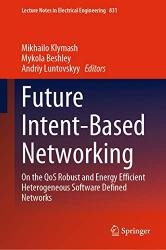Future Intent-Based Networking: On the QoS Robust and Energy Efficient Heterogeneous Software Defined Networks
- Добавил: literator
- Дата: 13-12-2021, 18:10
- Комментариев: 0
 Название: Future Intent-Based Networking: On the QoS Robust and Energy Efficient Heterogeneous Software Defined Networks
Название: Future Intent-Based Networking: On the QoS Robust and Energy Efficient Heterogeneous Software Defined NetworksАвтор: Mikhailo Klymash, Mykola Beshley
Издательство: Springer
Год: 2022
Страниц: 531
Язык: английский
Формат: pdf (true)
Размер: 35.3 MB
So-called Intent-Based Networking (IBN) is founded on well-known SDN (Software-Defined Networking) and represents one of the most important emerging network infrastructure opportunities. The IBN is the beginning of a new era in the history of networking, where the network itself translates business intentions into appropriate network configurations for all devices. This minimizes manual effort, provides an additional layer of network monitoring, and provides the ability to perform network analytics and take full advantage of machine learning. The centralized, software-defined solution provides process automation and proactive problem solving as well as centralized management of the network infrastructure. With software-based network management, many operations can be performed automatically using intelligent control algorithms (Artificial Intelligence and Machine Learning). As a result, network operation costs, application response times and energy consumption are reduced, network reliability and performance are improved, network security and flexibility are enhanced. This will be a benefit for existing networks as well as evolved LTE-based mobile networks, emerging Internet of Things (IoT), Cloud systems, and soon for the future 5G/6G networks. The future networks will reach a whole new level of self-awareness, self-configuration, self-optimization, self-recovery and self-protection.
In Chapter 4 Infrastructure as Code and Microservices for Intent-Based Cloud Networking, authors present a new mechanism for deploying, managing infrastructure and creating and delivering microservices for future intent-based cloud networks. The process of building infrastructure is similar to the software programming process, where some scripts, modules, providers and version control systems are used together. The processes of building serverless microservices and how to create new content, reduce maintenance, scale easily and deliver new features to users faster have been explored. The main advantage of serverless platforms is that they allow you to focus on writing code without worrying about infrastructure management, auto-scaling or paying for more than you use. With Cloud Functions and Cloud Run, you can create high-quality microservices that improve the performance of your application or site. To ensure continuous integration and deployment of applications and infrastructure, enterprises will need DevOps tools in the future, which include intent-based networks (IBNs). Numerous manual tools and automated IT operations platforms are being replaced by Artificial Intelligence (AI), Machine Learning (ML) and network orchestration.
Скачать Future Intent-Based Networking
Внимание
Уважаемый посетитель, Вы зашли на сайт как незарегистрированный пользователь.
Мы рекомендуем Вам зарегистрироваться либо войти на сайт под своим именем.
Уважаемый посетитель, Вы зашли на сайт как незарегистрированный пользователь.
Мы рекомендуем Вам зарегистрироваться либо войти на сайт под своим именем.
Информация
Посетители, находящиеся в группе Гости, не могут оставлять комментарии к данной публикации.
Посетители, находящиеся в группе Гости, не могут оставлять комментарии к данной публикации.
